Series Circuit - Complete Toolkit
Objectives
-
To recognize a series circuit, to distinguish it from a parallel circuit, and to construct and/or interpret a schematic diagram of a series circuit.
-
To compare the values of current and electric potential at various locations within a series circuit and to explain the principles that form the basis of such comparisons.
-
To calculate the equivalent resistance of a series circuit from values of individual resistances.
-
To mathematically analyze a series circuit in order to relate the current value in each resistor to the battery voltage and the resistance values of the individual resistors.
-
To mathematically analyze a series circuit and use the Ohm’s law equation in order to determine the voltage drops across each resistor and to compare each of these values to the voltage of the battery.
Readings from The Physics Classroom Tutorial
-
Current Electricity Chapter, Lesson 4a - Circuit Symbols and Circuit Diagrams
-
Current Electricity Chapter, Lesson 4b - Two Types of Connections
-
Current Electricity Chapter, Lesson 4c - Series Circuits
Interactive Simulations
-
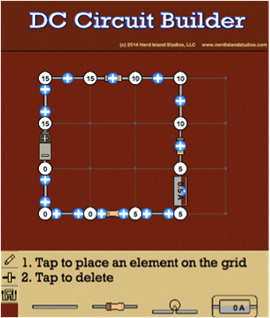 Nerd Island Studios DC Circuit Builder
Nerd Island Studios DC Circuit Builder
In cooperation with The Physics Classroom, Nerd Island Studios has produced an iPad, tablet, Chromebook, and mobile-friendly app for investigating electric circuits. Users can easily drag circuit elements onto the workspace to build any type of circuit. Battery voltage and resistance values can be easily modified, providing users with a virtual circuit kit capable of exploring circuit concepts. The DC Circuit Builder is accompanied by three different classroom-friendly and ready-to-use activities prepared by The Physics Classroom.
-
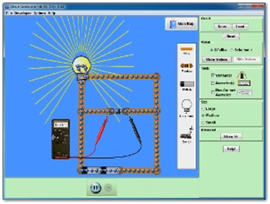 PhET DC Circuit Construction Kit
PhET DC Circuit Construction Kit
Robust interactive simulation lets students drag wires, batteries, resistors, bulbs, and switches to construct a model of a DC circuit. They can take measurements with the virtual ammeter and voltmeter. The circuit can be built in series, parallel, or more complex configurations. Right click, change the resistance, and watch the effects on the light bulb.
Note: Here’s an additional link to a comprehensive student guide, developed by a high school teacher specifically for use with this simulation.
http://phet.colorado.edu/en/contributions/view/3654
-
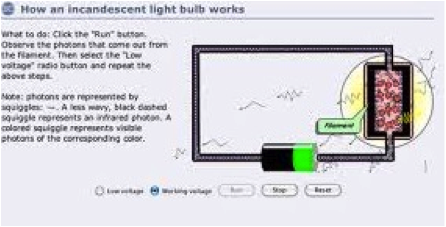 The Concord Consortium: Electric Current Model
The Concord Consortium: Electric Current Model
Take a deep exploration into the relationships between voltage, current, and resistance with this set of interactive models for introductory physics. It starts with atomic-level models to investigate how voltage and resistance affect electron flow. Then it explores how current is different from voltage and finishes with models of a hydrogen fuel cell and an incandescent light bulb filament. Students can take snapshots of their models, annotate them, and save or share. Allow 90 minutes.
-
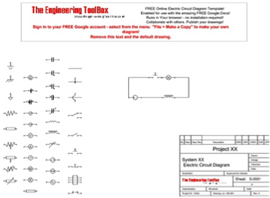 Electric Circuit Diagram Template
Electric Circuit Diagram Template
Login to your Google account to use this free tool for making sharable electric circuit diagrams. It’s part of the Google Engineering ToolBox. This tool is appropriate for more advanced students, as it allows choices of AC or DC, capacitance, variable inductors, and more.
Video and Animations
-
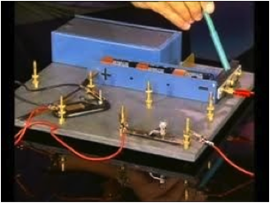 Education Commons: What Happens When a Current Passes Through a Circuit?
Education Commons: What Happens When a Current Passes Through a Circuit?
Good choice for a flipped lesson, this 14-minute video uses circuit board demos and animated circuit diagrams to explain what happens when current flows through two light bulbs in a circuit. Explicit explanations of why the current flow is greater in one of the bulbs in the series should help dispel the misconception that “the current is used up”.
-
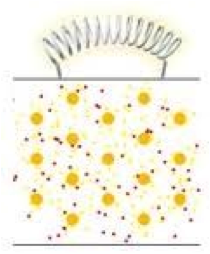 Molecular Expressions Animation: Resistance at the Molecular Level
Molecular Expressions Animation: Resistance at the Molecular Level
This very simple JAVA animation from Florida State University illustrates what happens to the movement of free electrons when voltage is applied across a conductor (a light bulb filament). It was developed to help students visualize that as electrons collide, the energy used to cause current flow is converted into heat and light.
Labs and Investigations
Demonstration Ideas
-
 PhET Teacher Contributions: Circuit Construction Kit Presentation
PhET Teacher Contributions: Circuit Construction Kit Presentation
Set of 13 Power Point slides for classroom formative assessment on series/parallel circuits. It was developed by a PhET “Gold-Star winning” high school teacher and can be accessed as a PDF for presentation or as a Power Point document with answers provided in annotations.
-
 MIT Tech TV Physics Demo: Conductivity of Ionized Water
MIT Tech TV Physics Demo: Conductivity of Ionized Water
In this 1-minute video demonstration, a light bulb is placed in series with two copper plates immersed in de-ionized water. Watch the bulb light up as the plates are touched together and turn off as they are pulled apart. But wait……kosher salt is dropped into the de-ionized water. The salt dissolves, causing ions to be dispersed throughout the liquid. The free ions allow current to flow through the water, completing the circuit and lighting the bulb.
Minds On Physics Internet Modules:
The Minds On Physics Internet Modules are a collection of interactive questioning modules that target a student’s conceptual understanding. Each question is accompanied by detailed help that addresses the various components of the question.
-
Electric Circuits, Assignment EC7 - Series Circuits Concepts
-
Electric Circuits, Assignment EC9 - Series Circuits Calculations
Link:
http://www.physicsclassroom.com/mop
Conceptual Building Exercises:
-
The Curriculum Corner, Electric Circuits, Series Circuits
-
The Curriculum Corner, Electric Circuits, Circuit Analysis
Link:
http://www.physicsclassroom.com/curriculum/circuits
Problem-Solving Exercises:
-
The Calculator Pad, Electric Circuits, Problems #20 - #28
Link:
http://www.physicsclassroom.com/calcpad/circuits
Science Reasoning Activities:
-
Science Reasoning Center, Electric Circuits, Bulb A and Bulb B
-
Science Reasoning Center, Electric Circuits, Series and Parallel Lab
Link:
http://www.physicsclassroom.com/reasoning/circuits
Real Life Connections:
-
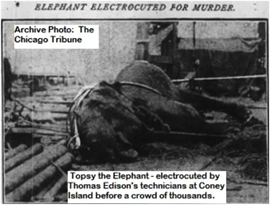 Edison vs. Westinghouse: A Shocking Rivalry
Edison vs. Westinghouse: A Shocking Rivalry
Science is the story of real people, real rivalries, heroic efforts, and (sometimes) not-so-heroic tactics. The “Battle of the Currents” pitted Thomas Edison (developer of the DC current system) against Nikola Tesla and George Westinghouse, proponents of AC power systems. Edison engaged in a smear campaign by using AC current systems to electrocute a dog, elephant, and even a condemned prisoner. He told shocked audiences that AC was dangerous and would kill them within months after installation. (This feature article from Smithsonian Magazine is an excellent resource for a lesson on ethics in scientific enterprise.)
-
 Department of Energy: The History of the Light Bulb
Department of Energy: The History of the Light Bulb
Nicely presented interactive timeline with background article that discusses the evolution of the light bulb. It covers the early arc lamp, Edison’s carbon-filament incandescent bulb, tungsten filament bulbs, fluorescent breakthroughs, Edward Hammer’s CFL (compact fluorescent light) and LED lighting.
Common Misconception:
-
Current Gets Used Up
It is helpful to often repeat the phrase “current is everywhere the same.” And it is also helpful to be on the lookout for the common and faulty student twist of this phrase into “current never changes.” Emphasize to students that the charge in a circuit is not used up or consumed. It simply flows about the circuit together when an electric potential difference is impressed across the circuit. So for a series circuit, each resistor in the series has the same current in it. Because students will be insistent that something is getting used up, describe the lowering of electric potential energy possessed by the charge as it passes through a resistor. This energy is being transformed into non-electrical forms (heat, light, mechanical, etc.). This conversion of energy causes the charge to lower its electrical potential as it passes through a circuit. Charge is not becoming used up; it is simply becoming less energized.
Related PER (Physics Education Research)
-
Students’ understanding of direct current resistive electric circuits, Engelhardt and Beichner, American Journal of Physics 72 (1), 98 (2004).
This article reports on the use of the DIRECT diagnostic test (Determining and Interpreting Resistive Electric Circuit Concepts Test) to analyze student understanding of DC circuit concepts. Researchers found that both high school and college students, especially females, held multiple misconceptions – even after instruction. The main source of misconception, according to the authors, is with confusion about the underlying mechanism of electric circuits and the meaning of “current”. Free download
Link: http://www.ncsu.edu/per/Articles/Engelhardt&Beichner.pdf
Elsewhere on the Web:
-
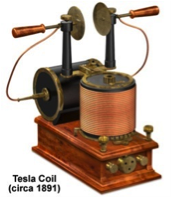 Museum of Electricity and Magnetism
Museum of Electricity and Magnetism
Great collection of stories about 50+ key inventions in the field of electricity and magnetism, all with high-quality photos of actual devices or replicas. You’ll find the Bell telephone, Tesla coil, cyclotron, electrophorus, the first hydroelectric power plant, Oersted’s compass, a Wimshurst machine, and more. From the Florida State University Digital Collection.
Assessments
-
All About Circuits: Series DC Circuits
A set of open-access problems with user-activated answer keys. The 27 problems, all related to series circuits, provide practice through multiple choice, fill-in-the-blanks, and completion of data tables.
Standards:
A. Next Generation Science Standards (NGSS)
Performance Expectations
-
High School – HS-PS2-6 Communicate scientific and technical information about why the molecular-level structure is important in the functioning of designed materials or systems.
-
High School – Develop and use models to illustrate that energy at the macroscopic scale can be accounted for as a combination of energy associated with the motions of particles and energy associated with the relative positions of particles.
Disciplinary Core Ideas
-
MS.PS2.B.i Electric and magnetic (electromagnetic) forces can be attractive or repulsive, and their sizes depend on the magnitudes of the charges, currents, or magnetic strengths involved and on the distances between the interacting objects.
-
HS-PS1.A.i The structure and interactions of matter at the bulk scale are determined by electrical forces within and between atoms
-
HS-PS3.A.i Electrical energy” may mean energy stored in a battery or energy transmitted by electric currents.
-
HS-PS3.D.i Although energy cannot be destroyed, it can be converted to less useful forms—for example, to thermal energy in the surrounding environment.
Crosscutting Concepts
Cause & Effect: Mechanism and Explanation –
-
Events have causes, sometimes simple, sometimes multifaceted. A major activity of science is investigating and explaining causal relationships and the mechanisms by which they are mediated.
Systems and System Models
-
Defining the system under study (specifying its boundaries and making explicit a model of that system) provides tools for understanding and testing ideas that are applicable through science and engineering.
Energy and Matter
-
Tracking fluxes of energy and matter into, out of, and within systems helps one understand the systems’ possibilities and limitations.
Science and Engineering Practices
Practice #2: Developing and Using Models
-
Develop and/or use multiple types of models to provide mechanistic accounts of phenomena
-
Develop and/or use a computational model to generate data to support explanations, predict phenomena, and analyze systems.
Practice #3: Planning and Carrying Out Investigations
-
Plan and conduct an investigation individually and collaboratively to produce data to serve as the basis for evidence … and consider limitations on the precision of the data
-
Select appropriate tools to collect, record, analyze, and evaluate data.
-
Collect data about a complex model or system to identify failure points or improve performance relative to criteria for success or other variables.
Practice #4: Analyzing and Interpreting Data
-
Analyze data using tools, technologies, and/or models to make valid and reliable scientific claims or determine an optimal design solution.
-
Analyze data to identify design features or characteristics of the components of a proposed system to optimize it relative to criteria for success.
Practice #5: Using Mathematics and Computational Thinking
-
Create and/or revise a computational model or simulation of a phenomenon, designed device, process, or system.
-
Use mathematical and/or algorithmic representations of phenomena or design solutions to describe and/or support claims and explanations.
-
Apply techniques of algebra and functions to represent and solve scientific and engineering problems.
-
Apply ratios, rates, percentages, and unit conversions in the context of complicated measurement problems involving quantities with derived or compound units.
Practice #6: Constructing Explanations
-
Construct and revise an explanation based on valid and reliable evidence obtained from a variety of sources (including students’ own investigations, models, theories, simulations) and the assumption that theories and laws that describe the natural world operate today as they did in the past and will continue to do so in the future.
Practice #8: Obtaining, Evaluating, and Communicating Information: High School
-
Critically read scientific literature adapted for classroom use to determine the central ideas or conclusions and/or to obtain scientific and/or technical information to summarize complex evidence, concepts, processes, or information presented in a text.
-
Gather, read, and evaluate scientific and/or technical information from multiple authoritative texts.
-
Communicate scientific and/or technical information or ideas in multiple formats (i.e., orally, graphically, textually, mathematically).
The Nature of Science
Scientific Investigations Use a Variety of Methods: High School
-
Scientific inquiry is characterized by a common set of values that include: logical thinking, precision, open-mindedness, objectivity, skepticism, replicability of results, and honest and ethical reporting of findings.
-
Scientific investigations use a variety of methods, tools, and techniques to revise and produce new knowledge.
B. Common Core Standards for Mathematics – Grades 9-12
Functions – Interpreting Functions
-
F-IF.4 – For a function that models a relationship between two quantities, interpret key features of graphs and tables in terms of the quantities, and sketch graphs showing key features.
-
F-IF.6 – Calculate and interpret the average rate of change of a function (presented symbolically or as a table) over a specified interval. Estimate the rate of change from a graph.
Linear, Quadratic, and Exponential Models
-
F-LE.1.b – Recognize situations in which one quantity changes at a constant rate per unit interval relative to another.
-
F-LE.5 – Interpret the parameters in a linear or exponential function in terms of a context.
C. Common Core Standards for English/Language Arts (ELA) – Grades 9-12
Key Ideas and Details: High School
-
RST.11-12.3 – Follow precisely a complex multistep procedure when carrying out experiments, taking measurements, or performing technical tasks; analyze the specific results based on explanations in the text.
-
RST.11-12 – Determine the central ideas or conclusions of a text; summarize complex concepts, processes, or information presented in a text by paraphrasing them in simpler but still accurate terms.
Craft and Structure – High School
-
RST.11-12.5 – Determine the meaning of symbols, key terms, and other domain-specific words and phrases as they are used in a specific scientific or technical context relevant to grades 11-12 texts and topics.
-
RST.11-12.6 – Analyze the author’s purpose in providing an explanation, describing a procedure, or discussing an experiment in a text, identifying important issues that remain unresolved.
Integration of Knowledge and Ideas – High School
-
RST.11-12.9 – Synthesize information from a range of sources (e.g., texts, experiments, simulations) into a coherent understanding of a process, phenomenon, or concept, resolving conflicting information when possible.
Range of Reading and Level of Text Complexity – High School
-
RST.11-12.10 -- By the end of grade 12, read and comprehend science/technical texts in the grades 11-CCR text complexity band independently and proficiently.
D. College Ready Physics Standards (Heller and Stewart)
Standard 4: Energy Transfer and Storage
Objective 4.2: Electric Circuit Interactions and Energy
-
Students understand that an electrical energy transfer from the source of electric current to the electrical device(s) in a circuit can change the energy stored in the system. All electrical devices transfer energy out of the system. The energy changes within the system depend on the properties of the electrical energy source and the electrical device(s) in the circuit. The electric charges that flow in the circuit are in the conductors of the circuit. A battery or other source moves electric charges through the circuit but does not create electric charges.
Middle School Boundary Statement: Students are introduced to qualitative ideas about series and parallel circuits, electric current as a flow of charge, and the idea that the charges that flow are in conductors all the time. They develop their skills in constructing and evaluating analog models.
Essential Knowledge M.4.2.1 – An electric circuit interaction occurs when an electrical energy source is connected with conducting wires in a complete loop (closed circuit) to an electrical device (e.g., light bulb, motor) which is an energy receiver. The evidence of the interaction is an electric current in the circuit.
High School Boundary Statement: In grades 9-12, students expand their knowledge of electric current to include an atomic model of electric current, and extend their knowledge to include potential difference and Ohm’s Law.
Essential Knowledge H.4.2.1 -- The electric current, which is the same everywhere in a circuit loop, is the amount of charge that flows past a given location each second. The measurement unit of current, the ampere, is equal to one Coulomb of charge per second (C/s).
Essential Knowledge H.4.2.2 -- Electric charge is conserved in a closed system such as a circuit. At a branch point (junction), the current flowing into the junction must equal the total current flowing out of the junction.
Essential Knowledge H.4.2.3 -- At the atomic scale, a useful analog model of metal conduction has a lattice of positively charged metal ions that are more or less fixed within a conductor, surrounded by a “sea” of mobile, negatively charged electrons. Using this model, one can demonstrate that electrons in metals typically “move” a few centimeters per hour, even during high currents. By convention, current is defined as the amount of positive charge that flows past a location each second.